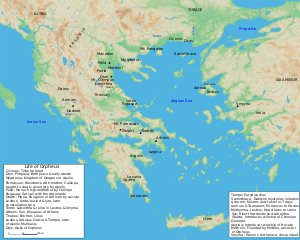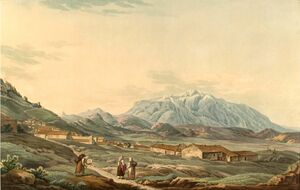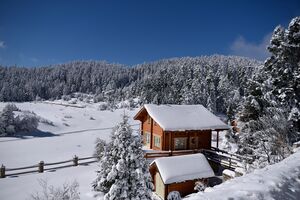جبل پارناسوس Mount Parnassus
| پارناسوس Parnassus | |
|---|---|
| Παρνασσός | |
 جبل پارناسوس | |
| أعلى نقطة | |
| الارتفاع | 2،457 m (8،061 ft)[1] |
| البروز | 1،590 m (5،220 ft)[1] |
| الإدراج | فائقة الارتفاع |
| الإحداثيات | 38°32′09″N 22°37′27″E / 38.53583°N 22.62417°E[1] |
| الجغرافيا | |
خطأ لوا في وحدة:Location_map على السطر 526: Unable to find the specified location map definition: "Module:Location map/data/اليونان" does not exist.
| |
 | |
| التسلق | |
| أسهل السبل | تسلّق |
جبل پارناسوس ( []pɑrˈnæsəs[]؛ Greek: Παρνασσός، Parnassós) هو سلسلة جبلية تقع في اليونان الوسطى، وقد كانت ولا تزال ذات أهمية كبيرة للأمة اليونانية ولدويلات المدن اليونانية القديمة لأسباب متعددة. ففي أوقات السلم، يتميز بإطلالاته الخلابة على الريف، ويُعد وجهة دولية رئيسية لممارسة الأنشطة الترفيهية في أحضان المناظر الجبلية. ومن الناحية الاقتصادية، تحتضن منحدراته وسهوله الواسعة غابات زيتون وفيرة تُعد محصولاً نقدياً مهماً يُسوّق عالمياً منذ عصور ما قبل التاريخ. كما يحتضن الجبل مواقع تاريخية وأثرية وثقافية، مثل دلفي القائمة على منحدراته الجنوبية في وادٍ صدعي شمال خليج كورنث.[2]
يضم پارناسوس العديد من المسارات المخصصة للمشي لمسافات طويلة خلال الفصول الدافئة الثلاثة، بينما يتحول في الشتاء إلى منطقة تزلج شهيرة، خاصة حول منتجعات أراخوڤا. كما تُعدّ مياه ذوبان ثلوجه مصدراً رئيسياً لمياه الشرب في القرى المجاورة. ويتكوّن الجبل أساساً من الحجر الجيري، إلا أنه يحتوي أيضاً على خام البوكسيت، الذي يُستخرج ويُعالج في المنطقة. وخلال فترات الحرب، كان الجبل مركزاً للمقاومة ومكاناً آمناً للأنصار.
ذُكر جبل پارناسوس في الأدب الإغريقي القديم، إذ أشار إليه هوميروس في الإلياذة. ومن الناحية اللغوية، كان موطناً لدول الدوريين مثل فوكيس، حيث كانت تُستخدم لهجة دورية تُعرف بـ«الفوكيسية». ووفقاً لـالميثولوجيا الإغريقية، كان الجبل مقدساً لدى ديونيسوس وأتباعه في الأسرار الديونيسية، كما كان مقدساً لـأبولو وحوريات كوريكيون، ويُعتقد أنه كان موطناً لـالميوزات.
ومع ذلك، توجد فجوة واضحة في التاريخ الأولي لاسم «پارناسوس». فعلى الرغم من أن مستوطنات اليونان الميسينية كانت منتشرة إلى الجنوب والشرق، وكان سكانها يشاهدون الجبل بوضوح ويصعدون أجزاءً منه، فإن الاسم لم يُذكر في ما وصلنا من اليونانية الميسينية المكتوبة بالخط الخط ب.
أصل الاسم
اقترح اللغوي ليونارد روبرت پالمر أن اسم «پارناسوس» مشتق من اللغة اللووية، وهي إحدى اللغات الأناضولية. ويرى پالمر أن الاسم ينبع من كلمة parnassas، وهي الصفة المضافة لكلمة parna في اللووية، وتعني «البيت» أو «المعبد»، أي أن الاسم يعني فعلياً «جبل بيت الإله».[3] وقد اعتُبرت هذه الفرضية قوية نظراً لاتساقها مع قدسية الجبل بوصفه مكاناً تُجسَّد فيه القوة الإلهية، حتى من قِبل منتقدي النظرية. ويواصل پالمر اقتراحه بأن بعض الشعوب ما قبل الإغريقية كانت من أصول أناضولية ربما جاءت ضمن موجات غزو مبكرة، وأن الإغريق الأوائل استولوا على أراضيهم ومرافقهم لاحقاً.
غير أن هذا الاتساق يتوقف هنا، إذ لا توجد أدلة أثرية أو تاريخية تربط الاسم بوجود أناضولي مؤكد. وقد بحث جورج إ. ميلوناس في الفرضيات الممكنة، ولم يجد ما يربط الآثار المحيطة بالجبل بشيء أناضولي، رغم وجود مؤشرات على صلة محتملة بكريت، إلا أنه لا دليل على ارتباط الكريتيين باللوويين.[4] ولا يزال الخط أ، الذي استخدمه المينويون في كريت، غير مفكوك، وبالتالي تبقى هوية الشعوب السابقة للإغريق غامضة، ولا تفسير دقيق لكيفية تسمية الجبل بهذا الاسم ذي الأصل اللووي.
الجيولوجيا والجغرافيا
يُعد پارناسوس من أكبر المناطق الجبلية في اليونان البرية ومن أعلى جبالها، إذ يمتد عبر ثلاث محافظات هي بيوتيا وفثيوتيس وفوكيس، وتقع معظم مساحته ضمن الأخيرة. ويبلغ ارتفاعه 2457 متراً (8061 قدماً)، وأعلى قممه تُعرف باسم «لياكورا». ويرتبط الجبل شمال غرباً بـجبل جيونا، وجنوباً بـ«كيرفه».
ويحد الجبل من الشرق وادي نهر كيفيس البويتي، ومن الغرب وادي أمفيسا. ومن خصائصه الجيولوجية المميزة غنى تربته برواسب البوكسيت التي استُخرجت منه بشكل منهجي منذ أواخر ثلاثينيات القرن العشرين، ما تسبب في أضرار بيئية لجزء من الجبل.[5]
المناخ
Mount Parnassus has very cold winters and cool summers. Below the data of the World Meteorological Organization station in the doline of Vathistalos.
| بيانات المناخ لـ دولينى ڤاثيستالوس 1780 م فوق سطح البحر (2017-2023) | |||||||||||||
|---|---|---|---|---|---|---|---|---|---|---|---|---|---|
| الشهر | ينا | فب | مار | أبر | ماي | يون | يول | أغس | سبت | أكت | نوف | ديس | السنة |
| القصوى القياسية °س (°ف) | 12.0 (53.6) |
13.1 (55.6) |
13.5 (56.3) |
19.0 (66.2) |
26.9 (80.4) |
26.2 (79.2) |
28.8 (83.8) |
29.8 (85.6) |
25.0 (77.0) |
22.8 (73.0) |
18.5 (65.3) |
14.1 (57.4) |
29.8 (85.6) |
| متوسط القصوى اليومية °س (°ف) | 2.1 (35.8) |
2.3 (36.1) |
4.1 (39.4) |
9.1 (48.4) |
13.8 (56.8) |
17.0 (62.6) |
20.3 (68.5) |
20.0 (68.0) |
16.2 (61.2) |
12.9 (55.2) |
7.8 (46.0) |
4.8 (40.6) |
10.9 (51.6) |
| المتوسط اليومي °س (°ف) | −3.3 (26.1) |
−2.7 (27.1) |
−0.7 (30.7) |
3.5 (38.3) |
7.9 (46.2) |
10.7 (51.3) |
13.3 (55.9) |
13.5 (56.3) |
9.7 (49.5) |
6.3 (43.3) |
3.2 (37.8) |
−0.4 (31.3) |
5.1 (41.2) |
| متوسط الدنيا اليومية °س (°ف) | −8.7 (16.3) |
−7.6 (18.3) |
−5.5 (22.1) |
−2.2 (28.0) |
2.0 (35.6) |
4.3 (39.7) |
6.2 (43.2) |
6.9 (44.4) |
3.2 (37.8) |
−0.3 (31.5) |
−1.5 (29.3) |
−5.6 (21.9) |
−0.7 (30.7) |
| الصغرى القياسية °س (°ف) | −28.6 (−19.5) |
−23.9 (−11.0) |
−28.1 (−18.6) |
−16.0 (3.2) |
−7.9 (17.8) |
−5.8 (21.6) |
−1.6 (29.1) |
−3.3 (26.1) |
−11.3 (11.7) |
−14.1 (6.6) |
−17.7 (0.1) |
−27.9 (−18.2) |
−28.6 (−19.5) |
| متوسط تساقط الأمطار mm (inches) | 46.8 (1.84) |
45.5 (1.79) |
98.5 (3.88) |
52.1 (2.05) |
69.3 (2.73) |
54.1 (2.13) |
21.2 (0.83) |
40.1 (1.58) |
163.9 (6.45) |
81.8 (3.22) |
108.2 (4.26) |
146.6 (5.77) |
928.1 (36.53) |
| Source 1: National Observatory of Athens Monthly Bulletins (Dec 2017 - Dec 2023) [6] | |||||||||||||
| Source 2: Vathistalos N.O.A station,[7] World Meteorological Organization[8] | |||||||||||||
الأسطورة

Mount Parnassus is named after Parnassos, son of the nymph Kleodora and the man Kleopompus. A city of which Parnassos was the leader was flooded by torrential rains. The citizens ran from the flood, following the howling of wolves, up the mountain slope. There, the survivors built another city called Lykoreia, which in Greek means "the howling of the wolves." While Orpheus was living[9] with his mother and his eight beautiful aunts on Parnassus, he met Apollo, who was courting the laughing muse Thalia. Becoming fond of Orpheus, Apollo gave him a little golden lyre and taught him to play it. Orpheus's mother taught him to write verses for singing. As the Oracle of Delphi was sacred to the god Apollo, so did the mountain itself become associated with Apollo. According to some traditions, Parnassus was the site of the fountain Castalia and the home of the Muses; according to other traditions, that honor fell to Mount Helicon, another mountain in the same range. As the home of the Muses, Parnassus became known as the home of poetry, music, and learning.

Parnassus was also the site of several unrelated minor events in Greek mythology.
- In some versions of the Greek flood myth, the ark of Deucalion comes to rest on the slopes of Parnassus. This is the version of the myth recounted in Ovid's Metamorphoses.
- Orestes spent his time in hiding on Mount Parnassus.
- Parnassus was sacred to the god Dionysus.
- The Corycian Cave, located on the slopes of Parnassus, was associated with Hermes and the Bee Maidens (Thriae) nymphs. It was later sacred to Pan and to the Muses.
- In Book 19 of The Odyssey, Odysseus recounts a story of how he was gored in the thigh during a boar hunt on Mount Parnassus in his youth.
Parnassus was also the home of Pegasus, the winged horse of Bellerophon.
ككناية

This relation of the mountain to the Muses offered an instigation for its "mystification" by the poetic-artistic Parnassism movement, established in France in the decade of 1866 to 1876 as a reaction to Romanticism. Parnassism was characterized by a return to some classicistic elements and belief in the doctrine of "Art for the Art", first articulated by Theophile Gautier. The periodical Modern Parnassus, issued by Catul Mendes and Xavier Ricard, contained direct references to Mt. Parnassus and its mythological feature as habitation of the Muses. The Parnassists, who did not exceed a group of twenty poets, exercised a relatively strong influence on the cultural life of Paris, particularly due to their tenacity in the perfection of rhyme and vocabulary. Parnassism influenced several French poets, but it also exercised an influence on modern Greek poets, particularly Kostis Palamas and Ioannis Gryparis.[10]
The name of the mountain (Mont Parnasse) was given to a quarter of Paris on the left bank of the Seine, where artists and poets used to gather and recite their poems in public. Montparnasse is nowadays one of the most renowned quarters of the city, and in its cemetery, many personalities of the arts and culture are buried.[5]
Parnassus figures earlier in Jonathan Swift's The Battle of the Books (1697) as the site of an ideological war between the ancients and the moderns.[11]
الاستخدام الترفيهي
منتزه وطني
The National Park of Parnassus was founded in 1938. The idea behind the park was to preserve the natural habitat, for which it was necessary to govern the disposition of its natural resources. However, the park did not include all the terrain considered to be in the range. The highest peaks were omitted.
Within a few years the park aspect of the land became dormant as Greece turned its attention toward ending the German occupation, and then after World War II, settling the Greek Civil War. Parnassus was in a unique position to serve as a center for resistance, as it had for the Greek war of independence. Battles were fought in the valleys surrounding the range.
When the wars were over and the region went back to being an active park, the new science of ecology brought changes to the park administration. Species were inventoried, endemic and endangered ones were identified, and the concept of a protected area was established. Parnassus National Park became a protected area for birds under the "Birds Directive." Subsequently, it acquired other protections under other laws as required by the EU. After 2000, it became Oros Parnassos, "Mount Parnassus," Natura 2000 protected area ID GR2410002. The two are not exactly identical. The national park is about 150 km2 (37،000 acre). The Natura 2000 area is about 344 km2 (85،000 acre), bringing the terrain not covered by the park under protection..
Among the endemic flora species under protection are the Cephalonian fir tree and the Parnassian peony (Paeonia parnassica). In the Park are to be found birds of prey, wolves, boars, badgers, and weasels.
منتج التزلج في بارناسوس
The slopes of Mount Parnassus are composed of two ski sections, Kellaria and Fterolakka, which together make up the largest ski center in Greece. A smaller ski center (only two drag lifts) called Gerontovrahos is across a ridge from Kellaria. Parnassus is mined for its abundant supply of bauxite which is converted to aluminium oxide and then to aluminium.[12]
The construction of the ski resort started in 1975 and was completed in 1976, when the first two drag lifts operated in Fterolaka. In 1981 the construction of a new ski area was completed in Kelaria, while in winter season 1987–1988 the chair lift Hermes started operating and connected the two ski areas. Both ski resorts continued expanding, and in 1993, the first high-speed quad in Greece was installed, named Hercules. In 2014–2015, two new hybrid lifts were installed along with a new eight-seater, replacing the old infrastructure.
Today, the Ski Center operates with 16 lifts, two hybrid ski lifts that combine an eight-seater Cabin and a six-seater chair, an eight-seater Cabin, a 4-seater chair lift, a 2-seater chair lift, six drag lifts, and four baby lifts. The ski center boasts 25 marked ski runs and about 15 ski routes of 36 km (22 mi) total length, while the longest run is 4 km (2 mi).
انظر أيضاً
References
- ^ أ ب ت [[1](http://peaklist.org/WWlists/ultras/EuroCoreP1500m.html) "Europe Ultra-Prominences"] Listed as "Liakoura". Peaklist.org. Retrieved 2012-02-19.
- ^ [[2](https://www.britannica.com/place/Mount-Parnassus) "Mount Parnassus | Delphi, Oracle, Mythology | Britannica"]. [www.britannica.com](http://www.britannica.com) (in الإنجليزية). Retrieved 2024-10-08.
{{cite web}}: Check|url=value (help) - ^ Palmer, Leonard R. (1965). Mycenaeans and Minoans (2nd ed.). New York: Alfred A. Knopf. p. 30.
- ^ Mylonas, George E. (1962). ["The Luwian Invasions of Greece" (PDF). Hesperia. 31 (3): 221–316. JSTOR 147122.
{{cite journal}}: Check|url=value (help)](https://www.ascsa.edu.gr/uploads/media/hesperia/147122.pdf}}) - ^ أ ب Racot, A., 1967,"Les Parnassiens, introduction and commentaries by M. Pakenham", presented by Louis Forestier, Aux Lettres modernes: collection avant-siècle
- ^ "Meteo.gr - Προγνώσεις καιρού για όλη την Ελλάδα".
- ^ "Latest Conditions in Vathistalos".
- ^ "World Meteorological Organization". Retrieved 14 July 2023.
- ^ The Greek Gods by Hoopes And Evslin, ISBN 0-590-44110-8, ISBN 0-590-44110-8, 1995, page 77 His father was a Thracian king; His mother the muse Calliope. For a while he lived on Parnassus with his mother and his eight beautiful aunts, and there met Apollo who was courting the laughing muse Thalia. Taken with Orpheus, Apollo gave him his little golden lyre and taught him to play. His mother taught him to make verses for singing.
- ^ "Ioannis Gryparis".
- ^ "The Battle of the Books by Jonathan Swift - Summary". Archived from the original on 2020-07-07. Retrieved 2025-03-20.
- ^ The Parnassos Ski Centre Archived 2006-08-22 at the Wayback Machine
External links
- Greek Mountain Flora
- "Óros Parnassos, Greece" on Peakbagger
 Chisholm, Hugh, ed. (1911). . دائرة المعارف البريطانية (eleventh ed.). Cambridge University Press.
Chisholm, Hugh, ed. (1911). . دائرة المعارف البريطانية (eleventh ed.). Cambridge University Press. {{cite encyclopedia}}: Cite has empty unknown parameter:|coauthors=(help)
- Pages using gadget WikiMiniAtlas
- CS1 errors: URL
- Short description with empty Wikidata description
- Coordinates not on Wikidata
- Infobox mapframe without OSM relation ID on Wikidata
- Articles containing Greek-language text
- مقالات المعرفة المحتوية على معلومات من دائرة المعارف البريطانية طبعة 1911
- Mount Parnassus
- Places in Greek mythology
- Two-thousanders of Greece
- National parks of Greece
- Ski areas and resorts in Greece
- Mountains of Central Greece
- Mountains of Greece
- Sacred mountains of Greece
- Tourist attractions in Central Greece
- Landforms of Phocis
- Natura 2000 in Greece
- Ultra-prominent peaks of Europe
- صفحات مع الخرائط

